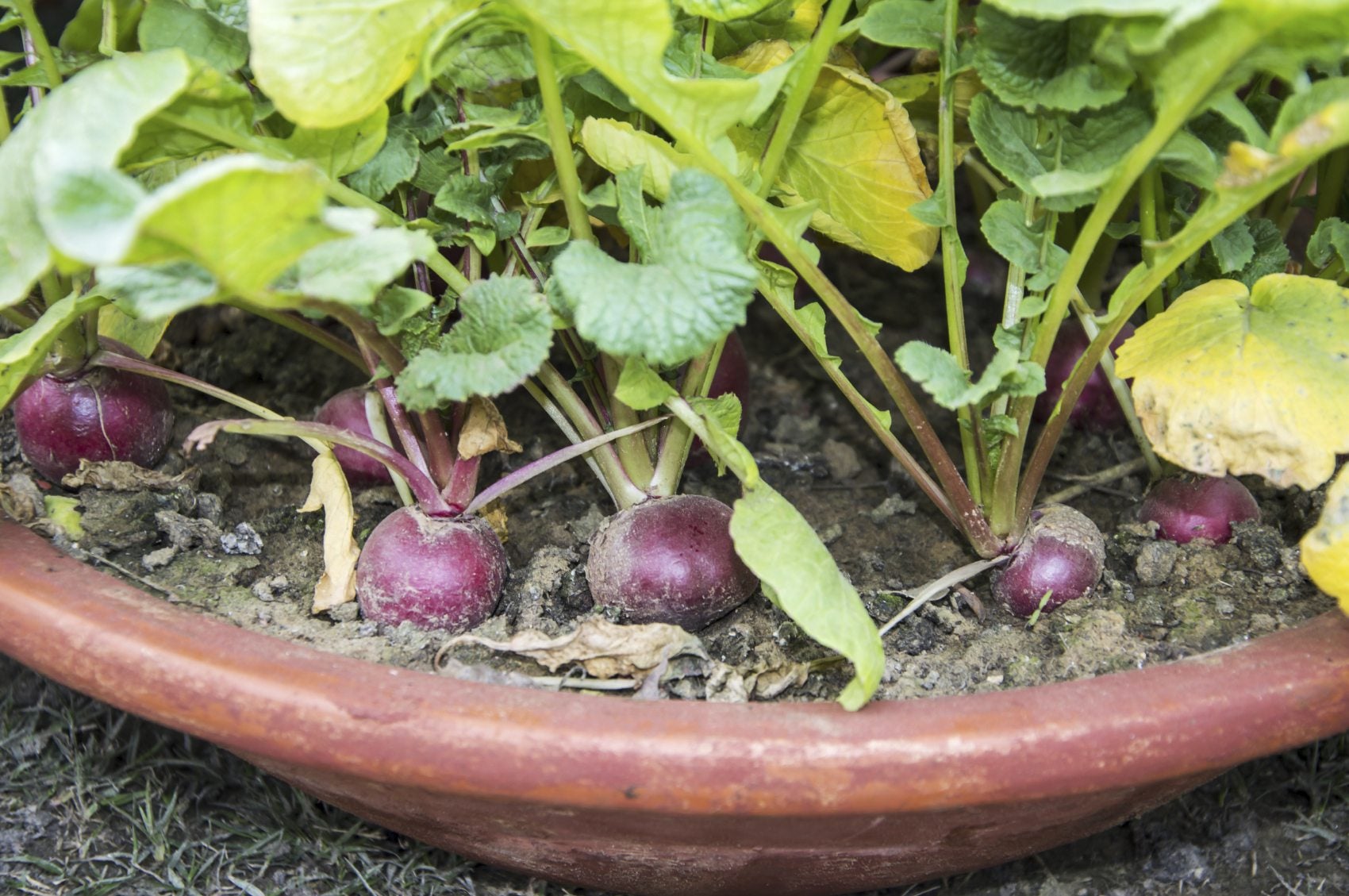
Radishes are vegetables grown for their edible underground root. The portion of the plant above ground is not to be forgotten, however. This part of the radish produces food for its growth and also stores additional nutrients needed down the growth phase. So, it comes as no surprise that yellow radish leaves are a sign that there is a radish growing problem. Why do radish leaves turn yellow and how can you treat a radish plant that has yellow leaves? Read on.
Why Do Radish Leaves Turn Yellow?
Radish growing problems may stem from anything from overcrowding, lack of adequate sun, competing weeds, insufficient water, nutrient deficiency, pests and/or disease. Radish leaves that are turning yellow may be the result of any number of the above as well. There are a number of diseases that result in yellowing leaves as at least one sign of infection. This may include septoria leaf spot, which is a fungal disease. Diseased foliage appears as yellow spots on radish leaves that look almost like water blotches with gray centers. Avoid Septoria leaf spot by amending with organic matter and planting in a well-draining area of the garden. Also, practice crop rotation. To curb the disease when plants are already afflicted, remove and destroy infected leaves and plants and keep the garden free of debris. Another fungal disease is blackleg. This infection presents as radish leaves turning yellow between the veins. The leaf margins brown and curl up while the stem becomes a dark brown to black and slimy. The roots also become slimy and brownish black towards the stem end. Again, prior to planting, amend the soil with plenty of organic matter and ensure that the site is well-draining, and practice crop rotation. If your radish plants become wilted and appear weak with yellow leaves combined with oval, red blotches at the stem base and roots with red streaks, you probably have a case of Rhizoctonia or Fusarium root (stem rot). This fungal disease thrives in warm soil. Rotate crops and plant disease free plants. Remove any infected plants and debris. Solarize the soil in the late spring or summer to kill off any overwintering spores. Club root is another fungal disease (Plasmodiophora brassicae) that not only cause leaves to yellow, but swells roots with tumor-like galls. This disease is common in wet soils with a low pH. The microorganism can live in the soil for 18 years or more after an infected crop! It spreads via soil, water, and wind movement. Practice long-term crop rotation and remove and destroy any crop detritus and weeds. Common in cool weather, downy mildew causes angular yellow spots on leaves that eventually become tan colored, papery textured areas surrounded by a yellow border. Fuzzy gray to white mold grows on the underside of the leaves and brown to black sunken areas appear on the root with a rough, cracked exterior. Black rot is yet another radish disease that results in yellowing leaves. In this case, the yellow areas are distinct V-shaped lesions on the margins of the leaves with the point of the “V” following a vein towards the base of the leaf. The leaves wilt, yellow, and soon brown and die as the disease progresses. The veins become black throughout the entire plant from leaves, stems, and petioles. Hot, humid conditions foster black rot, which may be confused with fusarium yellows. Unlike fusarium, ailing foliage in black rot coincides with bacterial slime.
Additional Reasons a Radish Plant Has Yellow Leaves
Yellow leaves on radish plants may also be due to insect infestation. A virus called aster yellows is a mycoplasma disease spread by leafhoppers, which act as a vector. To combat aster yellows, control the leafhopper population. Remove infected plants and keep the garden weed free since weeds harbor the disease by sheltering the leafhoppers. Brilliantly marked Harlequin bugs suck fluids from plant tissues, resulting in wilting plants with deformed leaves dotted with whitish or yellow spots. Handpick these insects and destroy their egg masses. Keep the garden free from weeds and plant detritus that will shelter the bugs and their eggs. Lastly, yellowing of radish leaves may also be the result of a nitrogen deficiency. This is fairly rare since radishes aren’t heavy feeders but, if necessary, feeding the plant with a fertilizer high in nitrogen will return the plant to its brilliant green. Start your radishes properly and you may be able to avoid many of these radish problems. Sow in a spot of at least six hours of sun per day. Prepare the area by raking free of weeds and debris. Work in ample compost or aged manure and rake the area smooth. Then sow seeds in furrows about an inch (2.5 cm.) apart and ½ inch (1 cm.) deep with seeds spaced ½ to 1 inch (1-2.5 cm.) apart. Cover lightly with soil and water in until moist. Keep the bed moist, not drenched, consistently. Thin the radishes, leaving 2 to 3 inches (5-8 cm.) between plants. Keep the bed free of weeds. Pick an occasional radish or two as they grow to check for any insects below the surface. Discard any infected plants immediately.
Sign up for the Gardening Know How newsletter today and receive a free copy of our e-book "How to Grow Delicious Tomatoes".

Amy Grant has been gardening for 30 years and writing for 15. A professional chef and caterer, Amy's area of expertise is culinary gardening.
